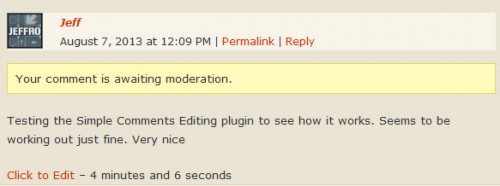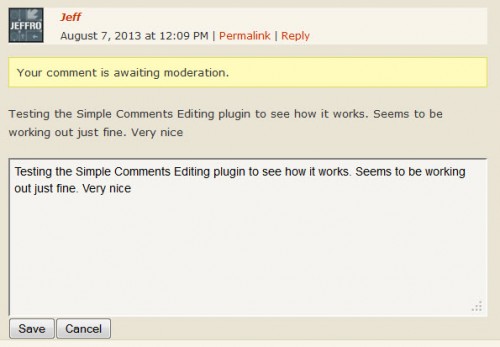Long time readers of this website will know that I love everything about the Ajax Edit Comments plugin by Ronald Huereca. In a nutshell, Ajax Edit Comments gave registered and anonymous users the opportunity to edit their own comments within a specific amount of time. The idea was inspired by Digg. Despite the vast array of configuration options AEC provided, Ronald has released a new, simplified version of the same plugin called Simple Comment Editing.


With Simple Comment Editing, Ronald has taken a new approach with the WordPress mantra of “Decisions, not options“. That’s why if you look around the back-end of WordPress for a link to configure the plugin, you won’t find it. This plugin contains no styles, performs comment editing inline, and defaults to a time limit of 5 minutes. However, for those that want to override some of the defaults, there are filters for that.
In my initial testing, the plugin performed flawlessly. It’s much quicker to edit comments inline versus the thickbox popup, it’s also easier on the eyes. I’m now torn between using this plugin or the full featured AEC which has some nice features such as Request Comment Deletion and a built-in spell checker via After The Deadline. While I sometimes hate the decisions, not options line of thinking, it works well in this instance.
So I renew my plea to all WordPress sites that enable commenting to please enable comment editing for anonymous users via the Simple Comment Editing plugin or by some other means. I know comments should be proof-read before hitting the publish button but that happens less than it should. It’s incredibly annoying to hit the publish button, find one typo and have no recourse. If you’d like to contribute to this plugin whether it be patches, bug reports, or translations, you can view the plugin source on GitHub.
Awesome. I’m a big fan of no-settings plugins because of the “it just works” aspect of it. And I have to say that I’ve always liked how you can edit comments here on WPTavern. I typo comments all the time, other times I like to improve my tone and being able to edit your own comments is great.